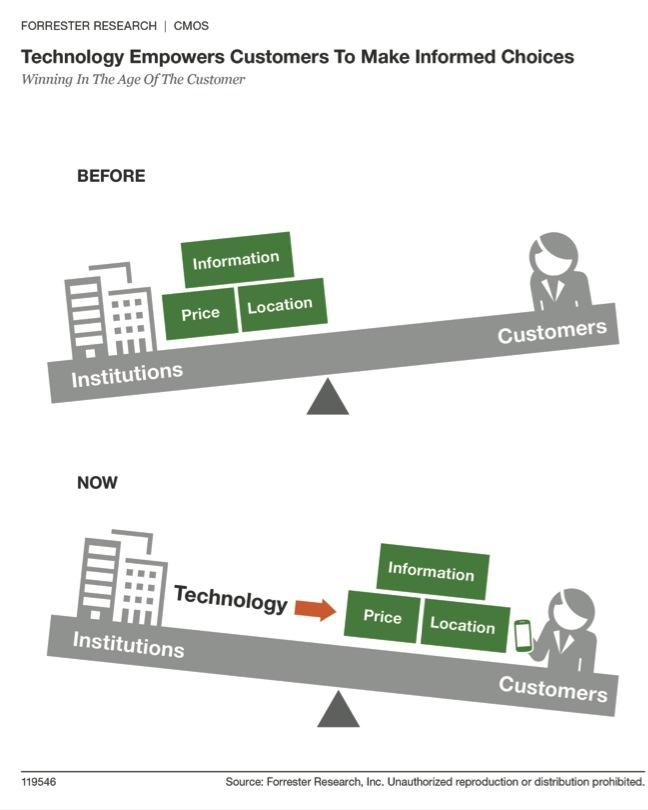Welcome to the next 20-year business cycle
Share
Become customer obsessed or fail, writes Michael Gazala, vice president and research director at Forrester Research.
 What’s the top imperative at your company? If it’s not a transformation to make the company more customer-focused, you’re making a mistake. Technology and economic forces have changed the world so much that an obsession with winning, serving and retaining customers is the only possible response. Welcome to the age of the customer – a 20-year business cycle in which the most successful enterprises will reinvent themselves to systematically understand and serve increasingly powerful customers.
What’s the top imperative at your company? If it’s not a transformation to make the company more customer-focused, you’re making a mistake. Technology and economic forces have changed the world so much that an obsession with winning, serving and retaining customers is the only possible response. Welcome to the age of the customer – a 20-year business cycle in which the most successful enterprises will reinvent themselves to systematically understand and serve increasingly powerful customers.
We’re in an era of persistent economic imbalances defined by erratic economic growth, deflationary fears, an oversupply of labour and surplus capital hunting returns in a sea of record-low interest rates. This abundance of capital and labour means the path from good idea to customer-ready product has never been easier, and seamless access to all of the off-the-shelf components needed for a start-up fuels the rise of ‘weightless companies’, which further intensify competition.
Chastened by a weak economy, presented with copious options and empowered with technology, consumers have more market muscle than ever before. The information advantage tips to consumers with ratings and review sites. They claim pricing power by showrooming. New mobile data streams, such as a consumer’s location, speed or fingerprint ID, enable entrepreneurs to serve customers cheaply, disrupting whole industries. The only location that matters is the mobile phone in their hand, from which they can buy anything from anyone and have it delivered anywhere.
This customer-driven change is remaking every industry. As news consumption shifted online and Craigslist and Monster swallowed classified ads, newspapers lost 50% of their revenue in the past five years. Cable and satellite operators lost almost 400,000 video subscribers in 2013 and 2014 as customers dropped them for the likes of Netflix. ATM networks, once a competitive advantage, are now a burden in a world of mobile cheque deposits. Lending Club, an alternative to commercial banks in the US, has facilitated more than US$6 billion in peer-to-peer loans.
Now that most B2B buyers would rather buy from a website than a salesperson, we estimate that one million B2B sales jobs will disappear in the coming years.
To thrive in the age of the customer, winning companies will embrace four mutually reinforcing market imperatives in order to become a customer-obsessed company:
- For speed, tap into mobile connections. Mobile technology – in the hands of customers or employees – can improve customer interactions and generate loyalty more quickly than any other change a company can make.
- For intelligence, set up systems to gather customer knowledge. By building a continual connection to customers and the analytical systems to act on the resulting data, enterprises can boost their knowledge of and responsiveness to customers.
- For impact, build a better customer experience. Customer obsession requires a systematic approach to improving customer experience. Act quickly on customer experience improvements with a simplified structure on products, services, processes and choice.
- To become flexible, embrace digital transformation. Analogue systems are hard to change. Digital systems, built on software, enable flexibility.
Most companies have made some progress on mobile, big data, customer experience and digital transformation initiatives. But the most advanced companies – including McDonald’s in France, Home Depot, Salesforce and T-Mobile – truly embrace customer obsession when their strategies combine these mutually reinforcing imperatives.
Delta Air Lines recognised that improving customer experience – with a focus on eliminating cancelled flights – could make a world of difference in its business. Mobile apps for customers, flight attendants and pilots streamline the experience for everyone. Making these applications sing required retooling back-end systems and led Delta to acquire staff and technology from travel technology firm Travelport. The result of this focus was a 13-point year-over-year jump in its Customer Experience Index score.
Transforming a company to become truly customer obsessed is difficult. As a result, not all companies will pursue it equally. The market dynamics of the future will emerge in the relationships between those that do, and those that don’t. Companies that continue to focus on short-term guidance – which, by definition, requires them to compete quarterly in a consistent way – will get disrupted by those that make the unpopular but more productive decision to invest in transformative, customer-driven changes.
The four marketing imperatives are your path to success, and business technology (BT) powers the change. To thrive in the age of the customer, CMOs (chief marketing officers) must partner with CIOs (chief information officers) to advance the BT (business technology) agenda, creating the technologies, systems and processes that increase agility, facilitate innovation and improve customer experience.
Forrester is a Marketing content partner – non-commercial collaborations with leading organisations on content for the magazine (like this article) as well as exclusive benefits for Marketing Advantage Members. Click here for more information.
















